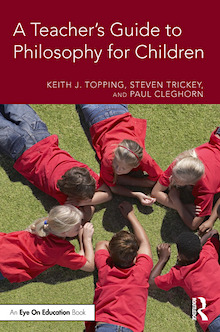How to Help Students Think for Themselves
A Teacher’s Guide to Philosophy for Children
By Keith J. Topping, Steven Trickey, and Paul Cleghorn
(Routledge/Eye On Education, 2019 – Learn more)
Reviewed by Erin Corrigan-Smith

A Teacher’s Guide to Philosophy for Children by Topping, Trickey, and Cleghorn is a short, comprehensive approach to coaching and engaging students in the process of thinking for themselves. Instead of being the giver of knowledge, teachers can focus on helping students discover the thought process necessary to finding the answer for themselves.

Each chapter is deeply and thoroughly researched, and there are many pages of references to indicate the research-based learning behind the authors’ assertions.
This is not light reading, but for readers willing to make the effort, it’s a book that can be used to support some solid classroom practices that will engage young minds.
Each chapter is well organized into subtopics, so while the reading is dense, it is not cumbersome. Each chapter begins with an in-depth introductory section and ends with a ‘micro’ review of the chapter in about a paragraph.
From chapter 3 on, the book focuses on how to implement philosophical thinking in the classroom setting. Each of these chapters is presented as a Stage, and there are clear-cut examples of what each stage looks like in the classroom. The authors give realistic suggestions for when to progress and how to progress through the stages, and the examples are well thought out.
Many of the strategies used in the book are common to good classrooms (e.g., Think-Pair-Share) but it is how these skills are used that may be new to readers.
Topping, Trickey, and Cleghorn are not proposing that teachers reinvent how they teach, but instead that they focus their instruction on engaging the minds of students through research-based inquiry. As students become better thinkers, instruction becomes more effective.
Erin Corrigan-Smith is a middle school ELA teacher in a suburb of Atlanta. She has a B.A. and M.A. in English, and her focus of study is children’s literature. During the school year, she is faculty advisor to the Book Worms book club. In her downtime, she enjoys going to her family’s cabin in the North Georgia mountains with her husband and dog, to read, craft, and relax.


































